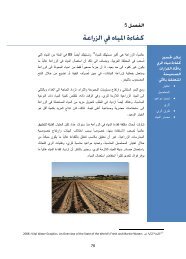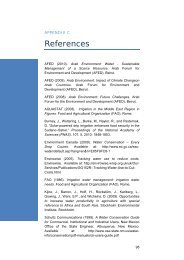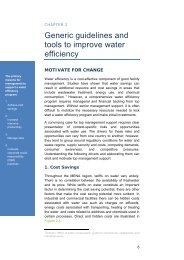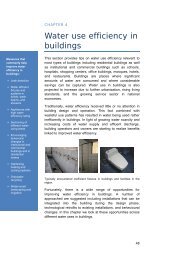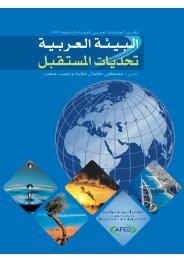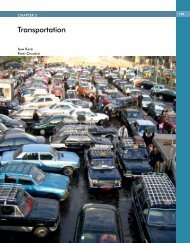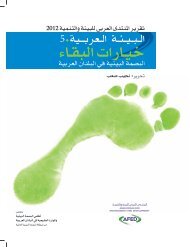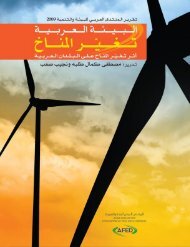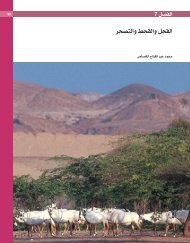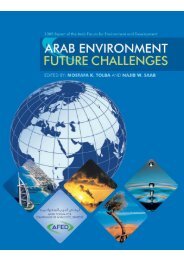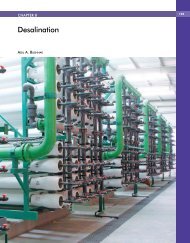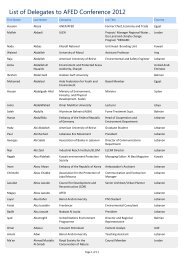Impact of Climate Change on Arab Countries - (IPCC) - Working ...
Impact of Climate Change on Arab Countries - (IPCC) - Working ...
Impact of Climate Change on Arab Countries - (IPCC) - Working ...
You also want an ePaper? Increase the reach of your titles
YUMPU automatically turns print PDFs into web optimized ePapers that Google loves.
ARAB ENVIRONMENT: CLIMATE CHANGE 45<br />
VII. CONCLUSION<br />
In the <strong>Arab</strong> world, segments <str<strong>on</strong>g>of</str<strong>on</strong>g> coastal areas are<br />
important and highly populated centres <str<strong>on</strong>g>of</str<strong>on</strong>g> industry,<br />
manufacturing and commerce. With its nearly<br />
34,000 km <str<strong>on</strong>g>of</str<strong>on</strong>g> coastline, the <strong>Arab</strong> world is susceptible<br />
to sea level rise. The potential exposure <str<strong>on</strong>g>of</str<strong>on</strong>g><br />
many <str<strong>on</strong>g>of</str<strong>on</strong>g> its countries and cities such as<br />
Alexandria, Dubai and many more to the impact<br />
<str<strong>on</strong>g>of</str<strong>on</strong>g> sea level rise may be fairly significant, based <strong>on</strong><br />
today’s socio-ec<strong>on</strong>omic c<strong>on</strong>diti<strong>on</strong> in coastal areas.<br />
After accounting for future development and<br />
populati<strong>on</strong> growth in these regi<strong>on</strong>s, sea level rise<br />
has been shown to pose important policy questi<strong>on</strong>s<br />
regarding present and future development<br />
plans and investment decisi<strong>on</strong>s.<br />
Notably, urbanized sandy coasts have been extensively<br />
cited as particularly vulnerable if future<br />
development is c<strong>on</strong>centrated close to the shoreline<br />
and if sensitive ecosystems exist in close proximity<br />
to these urbanized areas. Such regi<strong>on</strong>s will<br />
experience problems such as inundati<strong>on</strong>, coastal<br />
erosi<strong>on</strong> and impeded drainage. Moreover, the<br />
c<strong>on</strong>tinuing rapid and dense urban development<br />
<str<strong>on</strong>g>of</str<strong>on</strong>g> many areas in the <strong>Arab</strong> world would result in a<br />
dramatic alterati<strong>on</strong> <str<strong>on</strong>g>of</str<strong>on</strong>g> the land surface, as natural<br />
vegetati<strong>on</strong> is removed and replaced by n<strong>on</strong>-evaporating,<br />
n<strong>on</strong>-transpiring surfaces. Under such circumstances,<br />
surface temperature <str<strong>on</strong>g>of</str<strong>on</strong>g> these areas<br />
will rise by several degrees. On the l<strong>on</strong>g term,<br />
such urban Heat Island effect (UHI) could have<br />
severe negative c<strong>on</strong>sequences <strong>on</strong> the local weather<br />
<str<strong>on</strong>g>of</str<strong>on</strong>g> the <strong>Arab</strong> regi<strong>on</strong>, which in turn would c<strong>on</strong>tribute<br />
significantly to global warming.<br />
Furthermore, the increasing frequency <str<strong>on</strong>g>of</str<strong>on</strong>g> dust<br />
storms is <strong>on</strong>e <str<strong>on</strong>g>of</str<strong>on</strong>g> the serious envir<strong>on</strong>mental challenges<br />
facing the <strong>Arab</strong> regi<strong>on</strong>. Such storms would<br />
induce soil loss, decrease <str<strong>on</strong>g>of</str<strong>on</strong>g> precipitati<strong>on</strong> and agricultural<br />
productivity, dramatic reducti<strong>on</strong> <str<strong>on</strong>g>of</str<strong>on</strong>g> air<br />
quality and ultimately affect humanhealth.<br />
Although it seems that we are not totally prepared<br />
to face all such destructive effects <str<strong>on</strong>g>of</str<strong>on</strong>g> the SLR, UHI<br />
and dust storms, recent advances in remote sensing,<br />
increased availability <str<strong>on</strong>g>of</str<strong>on</strong>g> high resoluti<strong>on</strong> space<br />
imagery and the accessibility to more detailed<br />
datasets <str<strong>on</strong>g>of</str<strong>on</strong>g> digital elevati<strong>on</strong>, populati<strong>on</strong> and land<br />
cover-use, have all the potential to provide<br />
improved surveillance <str<strong>on</strong>g>of</str<strong>on</strong>g> such negative effects and<br />
their associated impacts <strong>on</strong> the entire <strong>Arab</strong> world.<br />
Such observati<strong>on</strong>al data can then be used as a solid<br />
basis up<strong>on</strong> which policies could be made.<br />
REFERENCES<br />
Church, J.A., N.J. White, T. Aarup, W.S. Wils<strong>on</strong>, P.L.<br />
Woodworth, C.M. Domingues, J.R. Hunter, and K.<br />
Lambeck, K. (2008). ‘Understanding global sea levels:<br />
past, present and future’. Sustainability Science, 3 (1):<br />
1-167.<br />
Douglas, B., R. Peltier, (2002). ‘The puzzle <str<strong>on</strong>g>of</str<strong>on</strong>g> global<br />
sea level rise’. Physics Today, 55 (3): 35-39.<br />
El-Raey, A. (1997).’ Vulnerability assessment <str<strong>on</strong>g>of</str<strong>on</strong>g> the<br />
coastal z<strong>on</strong>e <str<strong>on</strong>g>of</str<strong>on</strong>g> the Nile delta <str<strong>on</strong>g>of</str<strong>on</strong>g> Egypt, to the impacts<br />
<str<strong>on</strong>g>of</str<strong>on</strong>g> sea level rise’. Ocean & Coastal Management, 37<br />
(1): 29-40.<br />
Gh<strong>on</strong>eim, E. (2008). ‘Optimum groundwater locati<strong>on</strong>s<br />
in the northern Unites <strong>Arab</strong> Emirates’. Internati<strong>on</strong>al<br />
Journal <str<strong>on</strong>g>of</str<strong>on</strong>g> Remote Sensing, 29 (20): 5879-5906.<br />
Gh<strong>on</strong>eim, E. and El-Baz, F. (2007). ‘The applicati<strong>on</strong> <str<strong>on</strong>g>of</str<strong>on</strong>g><br />
radar topographic data to mapping <str<strong>on</strong>g>of</str<strong>on</strong>g> a megapaleodrainage<br />
in the Eastern Sahara’. Journal <str<strong>on</strong>g>of</str<strong>on</strong>g> Arid<br />
Envir<strong>on</strong>ments, 69: 658-675<br />
Gh<strong>on</strong>eim, E., C. Robins<strong>on</strong>, and F. El-Baz, (2007).<br />
‘Relics <str<strong>on</strong>g>of</str<strong>on</strong>g> ancient drainage in the eastern Sahara<br />
revealed by radar topography data’. Internati<strong>on</strong>al<br />
Journal <str<strong>on</strong>g>of</str<strong>on</strong>g> Remote Sensing, 28 (8): 1759-1772<br />
Gornitz, V. (2000). Coastal Populati<strong>on</strong>s, Topography,<br />
and Sea Level Rise. NASA GISS, Science Briefs.<br />
<strong>IPCC</strong> (2001). <str<strong>on</strong>g>Climate</str<strong>on</strong>g> <str<strong>on</strong>g>Change</str<strong>on</strong>g> 2001: Synthesis report,<br />
by R. Wats<strong>on</strong> and the Core Writing Team (eds.)<br />
Cambridge, UK: Cambridge University Press.<br />
<strong>IPCC</strong> (2007). <str<strong>on</strong>g>Climate</str<strong>on</strong>g> <str<strong>on</strong>g>Change</str<strong>on</strong>g> 2007: The Physical<br />
Science Basis. Summary for Policymakers. <strong>Working</strong><br />
Group I <str<strong>on</strong>g>of</str<strong>on</strong>g> the Intergovernmental Panel <strong>on</strong> <str<strong>on</strong>g>Climate</str<strong>on</strong>g><br />
<str<strong>on</strong>g>Change</str<strong>on</strong>g>.<br />
Landsberg, H.E. (1981). The Urban <str<strong>on</strong>g>Climate</str<strong>on</strong>g>. New<br />
York: Academic Press.<br />
Miller, L., and B. Douglas (2004). ‘Mass and volume<br />
c<strong>on</strong>tributi<strong>on</strong>s to twentieth-century global sea level<br />
rise’. Nature, 428: 406-409.<br />
Rahmstorf, S. (2007). ‘A Semi-Empirical Approach to<br />
Projecting Future Sea-Level Rise’. Science, 315: 368-<br />
370.<br />
Rosenfeld, F., Y. Rudich, and R. Lahav, (2001).<br />
‘Desert dust suppressing precipitati<strong>on</strong>: A possible<br />
desertificati<strong>on</strong> feedback loop’. Geophysics, 98 (11):<br />
5975-5980.<br />
Stanley, J.D. (1996). ‘Nile Delta: Extreme case <str<strong>on</strong>g>of</str<strong>on</strong>g><br />
sediment entrapment <strong>on</strong> a delta plain and c<strong>on</strong>sequent<br />
coastal land loss’. Marine Geology, 129: 189-195.<br />
Stanley, J.D. (2005). ‘Submergence and burial <str<strong>on</strong>g>of</str<strong>on</strong>g><br />
ancient coastal sites <strong>on</strong> the subsiding Nile delta<br />
margin, Egypt’. Méditerranée, 104: 65-73.



